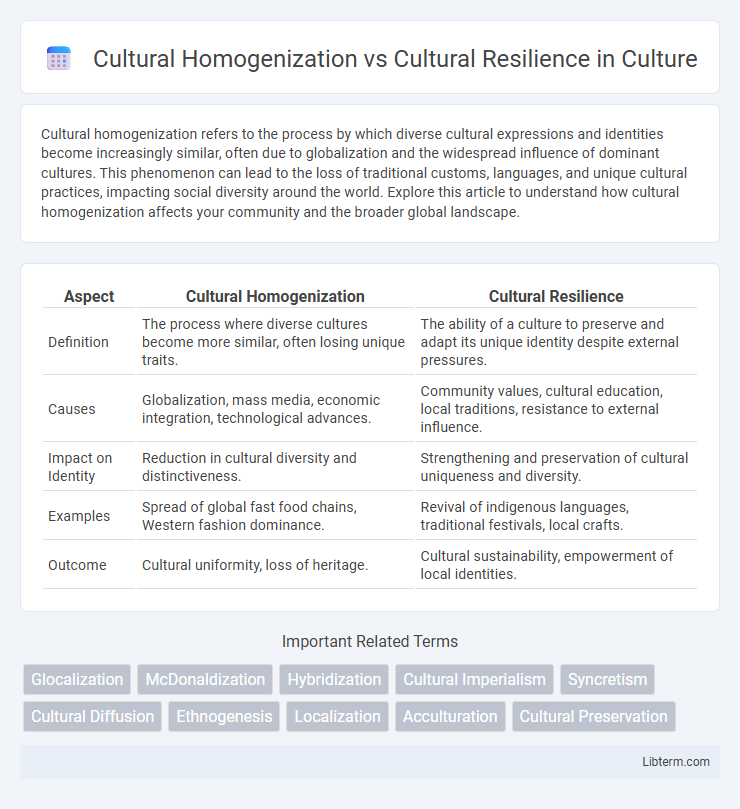Cultural homogenization refers to the process by which diverse cultural expressions and identities become increasingly similar, often due to globalization and the widespread influence of dominant cultures. This phenomenon can lead to the loss of traditional customs, languages, and unique cultural practices, impacting social diversity around the world. Explore this article to understand how cultural homogenization affects your community and the broader global landscape.
Table of Comparison
| Aspect | Cultural Homogenization | Cultural Resilience |
|---|---|---|
| Definition | The process where diverse cultures become more similar, often losing unique traits. | The ability of a culture to preserve and adapt its unique identity despite external pressures. |
| Causes | Globalization, mass media, economic integration, technological advances. | Community values, cultural education, local traditions, resistance to external influence. |
| Impact on Identity | Reduction in cultural diversity and distinctiveness. | Strengthening and preservation of cultural uniqueness and diversity. |
| Examples | Spread of global fast food chains, Western fashion dominance. | Revival of indigenous languages, traditional festivals, local crafts. |
| Outcome | Cultural uniformity, loss of heritage. | Cultural sustainability, empowerment of local identities. |
Understanding Cultural Homogenization
Cultural homogenization refers to the process by which local cultures become increasingly similar due to globalization, leading to the dominance of a few global cultural norms and practices, often driven by multinational corporations, media, and technology. This phenomenon results in the erosion of indigenous languages, traditions, and identities as global consumer culture and Western values penetrate diverse societies. Understanding cultural homogenization requires analyzing the impact of mass communication, economic globalization, and migration on cultural diversity and local heritage preservation.
Defining Cultural Resilience
Cultural resilience refers to the ability of a community or group to preserve and adapt its cultural identity, traditions, and practices despite external pressures or influences that promote cultural homogenization. It encompasses the strategies and mechanisms through which cultures maintain their distinctiveness and continue to thrive amid globalization, migration, and technological changes. This resilience ensures the survival and vitality of cultural diversity in a rapidly integrating world.
Historical Roots of Cultural Change
The historical roots of cultural change reveal a tension between cultural homogenization and cultural resilience, where globalization and colonialism have often driven the spread of dominant cultural norms, languages, and practices worldwide, leading to a more uniform global culture. In response, many communities have maintained cultural resilience by preserving indigenous traditions, languages, and customs through oral histories, rituals, and local governance systems that reinforce identity and heritage. This dynamic interplay shapes contemporary cultural landscapes, highlighting how historical processes influence both the erosion and preservation of cultural diversity.
Factors Driving Cultural Homogenization
Globalization, mass media, and technological advancements accelerate cultural homogenization by promoting dominant cultural norms and values. Economic integration and transnational corporations standardize consumer behavior, reducing cultural diversity. Urbanization and migration contribute to the blending and sometimes erasure of localized traditions and languages.
Mechanisms Sustaining Cultural Resilience
Mechanisms sustaining cultural resilience include language preservation, intergenerational knowledge transmission, and community-driven educational programs that reinforce traditional values and practices. Social networks and cultural institutions play critical roles in fostering a sense of identity and collective memory, enabling communities to adapt without losing their distinct cultural traits. These processes counterbalance cultural homogenization by promoting diversity and encouraging active cultural participation.
Impact of Globalization on Local Cultures
Globalization accelerates cultural homogenization by spreading dominant cultural practices, languages, and consumer behaviors, often overshadowing local traditions and identities. Despite this pressure, cultural resilience manifests as communities actively preserve and revitalize indigenous customs, languages, and heritage through education, festivals, and digital platforms. The dynamic between global influences and localized responses shapes a complex cultural landscape where both assimilation and cultural preservation coexist.
Case Studies: Homogenization vs Resilience
Case studies reveal that cultural homogenization often emerges from globalization, exemplified by widespread adoption of Western consumer brands in urban centers, which can erode local traditions and languages. In contrast, cultural resilience surfaces in communities like the Maori in New Zealand, who actively revive and integrate indigenous practices through education and media to maintain cultural identity. These examples highlight how cultural resilience strategies counteract homogenization by reinforcing unique cultural expressions despite global pressures.
Media Influence on Cultural Identity
Media acts as a powerful agent in cultural homogenization by disseminating dominant cultural narratives and values globally, often leading to the erosion of indigenous traditions and languages. However, media platforms also serve as tools for cultural resilience by enabling marginalized communities to promote, preserve, and revitalize their unique cultural identities through localized content and digital storytelling. The dynamic interplay between global media influence and localized cultural expression shapes the evolving landscape of cultural identity in the modern world.
Strategies for Preserving Cultural Diversity
Preserving cultural diversity requires implementing strategies such as promoting indigenous languages through education and media, supporting local art and craftsmanship, and protecting traditional knowledge from exploitation. Community-driven initiatives that prioritize cultural heritage and intercultural dialogue strengthen resilience against cultural homogenization caused by globalization. Policies encouraging cultural sustainability and inclusive representation in cultural policies further empower communities to maintain their unique identities and practices.
The Future Balance: Homogenization or Resilience?
Cultural homogenization threatens to erode unique traditions and languages as globalization promotes a dominant, often Westernized, culture worldwide. However, cultural resilience manifests through communities actively preserving, adapting, and revitalizing their heritage, ensuring survival amid external pressures. The future balance hinges on leveraging digital technology and inclusive policies that empower cultural diversity while fostering global interconnectedness.
Cultural Homogenization Infographic

 libterm.com
libterm.com